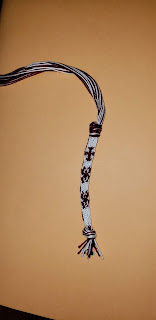I have been contemplating for a while on ways to make period appropriate trims or small weavings, and had generally been curious as to whether tablet weaving was period for a 16th century persona. When cursory research down that route proved inconclusive, I started to look at fingerloop braiding. My wife already had the wonderful book Tak V Bowes Departed, but this talks about a 15th century manual. I did some braids anyway to learn the techniques, and started digging further.
As I dug, I found references to later manuals: https://fingerloop.org/ has two 17th century manuals, but with limited pictures & samples. And then I started looking at bibliographies. Eventually I found that The Met had put almost the entire Phelita Millward manuscript, with blow ups of the samples, on Pinterest, and I was hooked. That spider motif kept calling my name, and I just had to figure it out. Unfortunately, there's no text around the motifs, just these charts which are nigh undecipherable without the right resources.
Some of the best early resources for loop braiding come from the author Noemi Speiser, but the one referenced over and over again, Old English Pattern Books for Loop Braiding, is out of print and was a self-published book. I got lucky and found it in a local university textile library (NC State), and thanks to a friend that works there, I had it in my hands. In addition to that, the follow-on set of books by Noemi Speiser and Joy Boutrup, specifically European Loop Braiding: Part II: Instructions for Letter Braids, was instrumental in deciphering these motifs and charts. I finally had all the resources in hand to make that spider, and oh was I excited.
Luckily, I'm married to a fellow re-enactor and textile enthusiast, so we practiced the technique for a 7-loop Spanish braid using both the Boutrop and the lovely blog post from Ingrid Crickmore which is the basis of the 14-loop charted motif braids. Working out most of the hiccups there, we attempted the spider the next night and all I can say is SUCCESS:
For those that care, the materials used for all of my samples so far is Aunt Lydia's Classic 10 Crochet Thread. It's easy to find, comes in a wide variety of colors, and is big enough for me to see what's going on while I'm learning. I'm hoping to get a complete sample book of all the braids in Tak V soon.



